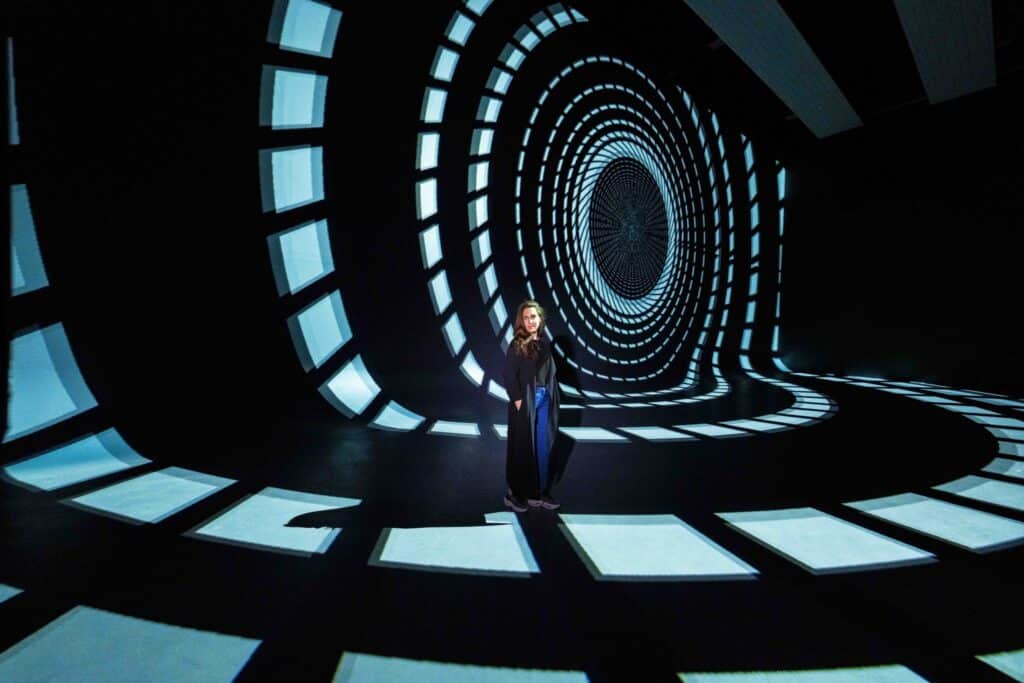
During the outbreak of corona, Merel van Helsdingen opened Nxt Museum, the first museum in the Netherlands to show new-media art that merges science, technology and art. With the, often overwhelming, installations, she aims to address topics of the future and make social issues discussable that affect how we interact with technology. "Here you really get an experience. "Text: Bart-Jan Brouwer
Image: John van Helvert
"I worked at tech companies in London, including Apple, and was always in a creative environment working with technology and progress. I also worked at advertising agency BBH, where we did Twitter campaigns with British Airways and had partnerships with Disney, Rovio and YouTube. And I was one of the first employees at Crowdmix, really a "classic Silicon Valley startup" story. They had raised 14 million pounds and built a new app - a social network for musicians and music lovers, to which you could link all the streaming services. After two years, the company went bankrupt. Very unfortunate that it ended this way, but I learned so much there! Also especially what not to do as an entrepreneur."
"Growing too fast, hiring too many people too fast. I think there was a very big mistake there. Within no time we went from thirty-five to a hundred and fifty people, while still not making any money. I did learn those kinds of lessons. And also that you don't have to do everything in-house, but some things are better left to external parties. With Nxt Museum, for example, we have partners in the field of technology and ticketing. You don't have to build everything yourself."
"I went back to the Netherlands, where I spent another two years at PVH doing e-commerce, business development, for fashion brands Tommy Hilfiger and Calvin Klein. But in the meantime I was itching to become an entrepreneur myself and set up a museum around digital art. Late 1900s, early 2000s, this art form was booming, only there was no place for it in the traditional museum world. That's why this movement was very much pulling towards festivals: Playgrounds, TodaysArt, MUTEK, Burning Man ... But it wasn't in one permanent place in a museum yet."
"Art was always a hobby of mine. I lived in London for seven years and in Paris for six months. In both cities I went to a museum at least once a week. Eye opener was an installation by Olafur Eliasson in Tate Modern's Turbine Hall, The Weather Project. Mirrors hung all over the ceiling, and underneath he mimicked a sun with hundreds of LED lights. In addition, he created a kind of fog through which the light spread a soft yellow and orange glow. Sound, image and light made me completely absorbed in that work of art. Not only mentally, but also physically. I found that so special. Since then, I started following installation art with digital technology."
"During the time I worked for PVH, I worked on the business plan in the evenings. Meanwhile, I started doing research, talking to people. Then you think 'the time isn't right yet' and the idea goes back on the shelf. When a similar place opened in both New York and Paris and I saw the attendance numbers there, I knew I had to do it now before someone else ran with the idea. I had so clearly in my head what it should be, that I quit my job then and went full steam ahead."
"Coming up with the legal form. Soon I knew it had to be a BV. In the Dutch art world this is fairly unique: most museums are foundations. However, I learned in tech that if you want to be agile and be able to move and build quickly, it's better not to set up a foundation with all the grant applications and approvals that that entails. The freedom this brings when it comes to curating the exhibition, working with outsider artists, for example, was also a deciding factor. Next, I had to raise funding. But in order to calculate how much money I needed, I had to have a location. That kind of went hand in hand. For over a year I looked for locations; I saw as many as thirty-five properties in Amsterdam. I had a number of conditions. First, the building had to have high ceilings, for optimal use of projectors and maximum experience. Second, it had to have adequate electricity supplies. Funnily enough, an old power plant fell through because it did not have enough power. Third, it had to be able to produce considerable noise, so a location in a residential area was a no go. I had some sort of shed in mind, preferably in Amsterdam-North, because that is the most multicultural creative place in the city. Through word of mouth, I ended up at this former television studio."
You can read the entire interview in MASTERS #46. Never miss anything from MASTERS? With 4 high-profile MASTERS editions, the annual LXRY LIST and many more extras, you will easily receive lots of reading pleasure at home: substantive reports, great photography and unique brands, trends and places in the world. Give it to yourself or a loved one as a gift. Close your subscription easily here.Photo: John van Helvert
© 2024 MASTERS EXPO. All rights reserved.